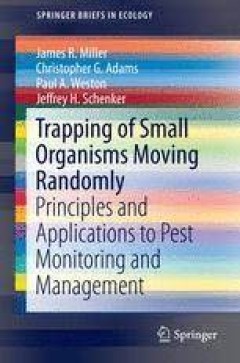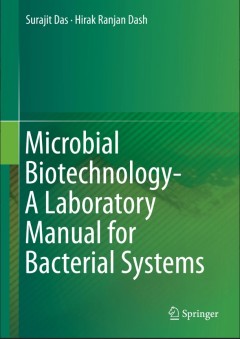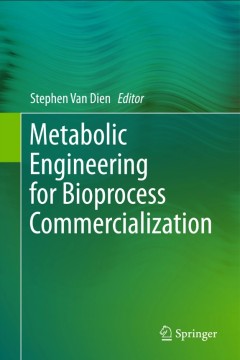Filter by

Trapping of Small Organisms Moving Randomly
This new book is the first to make logical and important connections between trapping and foraging ecology. It develops and describes—both verbally and mathematically--the underlying principles that determine and define trap-organism interactions. More important, it goes on to explain and illustrate how these principles and relationships can be used to estimate absolute population densities i…
- Edition
- 1
- ISBN/ISSN
- 978-3-319-12994-5
- Collation
- XVIII, 114
- Series Title
- SpringerBriefs in Ecology
- Call Number
- -

Ethylene in Plants
This book focuses on recent advances in our understanding of the signal transduction pathway of ethylene, its interaction with other hormones and its roles in biological processes. It discusses at which point plants could have acquired ethylene signaling from an evolutionary perspective. Ethylene was the first gaseous hormone to be identified and triggers various responses in higher plants. Our…
- Edition
- -
- ISBN/ISSN
- 978-94-017-9484-8
- Collation
- 6 b/w illustrations, 36 illustrations in colour
- Series Title
- -
- Call Number
- -

Epistemological Dimensions of Evolutionary Psychology
As psychology and philosophy arose as answers to the eternal question of how the mind works, evolutionary psychology has gained ground over recent years as a link between cognitive-behavioral and natural-science theories of the mind. This provocative field has also gathered a wide range of criticisms, from attributing too much autonomy to the brain to basing itself on faulty assu…
- Edition
- -
- ISBN/ISSN
- 978-1-4939-1387-9
- Collation
- 9 b/w illustrations, 6 illustrations in colour
- Series Title
- -
- Call Number
- -

The Science of Human Evolution
This textbook provides a collection of case studies in paleoanthropology demonstrating the method and limitations of science. These cases introduce the reader to various problems and illustrate how they have been addressed historically. The various topics selected represent important corrections in the field, some critical breakthroughs, models of good reasoning and experimental design, and im…
- Edition
- -
- ISBN/ISSN
- 978-3-319-41585-7
- Collation
- -
- Series Title
- -
- Call Number
- -

Electrophysiology of Unconventional Channels and Pores
This book is dedicated to the channels and pores that belong to an eclectic and ubiquitous class of unconventional - perhaps at times strange - pore-forming molecules, which nevertheless play fundamental roles in various organisms. These non-canonical channels may take on various and sometimes complex architectures, such as large beta-barrels or lipid-containing pores. They may originate from b…
- Edition
- 1
- ISBN/ISSN
- 978-3-319-20149-8
- Collation
- XI, 385
- Series Title
- -
- Call Number
- -

Microbial Biotechnology- A Laboratory Manual for Bacterial Systems
Microorganisms play an important role in the maintenance of the ecosystem structure and function. Bacteria constitute the major part of the microorganisms and possess tremendous potential in many important applications from environmental clean up to the drug discovery. Much advancement has been taken place in the field of research on bacterial systems. This book summarizes the experimental setu…
- Edition
- 1
- ISBN/ISSN
- 978-81-322-2094-7
- Collation
- XVI, 239
- Series Title
- -
- Call Number
- -

Metabolic Engineering for Bioprocess Commercialization
This volume reviews the current metabolic engineering tools and technologies from a practical point of view, and guides researchers as they overcome challenges at various stages of organism and bioprocess development. Microbes have been engineered to produce a variety of industrial products such as fuels, basic chemicals, fine chemicals, nutritional supplements, and pharmaceutical intermediates…
- Edition
- 1
- ISBN/ISSN
- 978-3-319-41964-0
- Collation
- V, 122
- Series Title
- -
- Call Number
- -

Microbial Biotechnology- A Laboratory Manual for Bacterial Systems
Microorganisms play an important role in the maintenance of the ecosystem structure and function. Bacteria constitute the major part of the microorganisms and possess tremendous potential in many important applications from environmental clean up to the drug discovery. Much advancement has been taken place in the field of research on bacterial systems. This book summarizes the experimental setu…
- Edition
- 1
- ISBN/ISSN
- 978-81-322-2094-7
- Collation
- XVI, 239
- Series Title
- -
- Call Number
- -

Metabolic Engineering for Bioprocess Commercialization
This volume reviews the current metabolic engineering tools and technologies from a practical point of view, and guides researchers as they overcome challenges at various stages of organism and bioprocess development. Microbes have been engineered to produce a variety of industrial products such as fuels, basic chemicals, fine chemicals, nutritional supplements, and pharmaceutical intermediates…
- Edition
- 1
- ISBN/ISSN
- 978-3-319-41964-0
- Collation
- V, 122
- Series Title
- -
- Call Number
- -

Atlas of Butterflies and Diurnal Moths in the Monsoon Tropics of Northern Aus…
Northern Australia is one of few tropical places left on Earth in which biodiversity—and the ecological processes underpinning that biodiversity—is still relatively intact. However, scientific knowledge of that biodiversity is still in its infancy and the region remains a frontier for biological discovery. The butterfly and diurnal moth assemblages of the area, and their intimate associatio…
- Edition
- -
- ISBN/ISSN
- 9781760462321
- Collation
- -
- Series Title
- -
- Call Number
- -
 Computer Science, Information & General Works
Computer Science, Information & General Works  Philosophy & Psychology
Philosophy & Psychology  Religion
Religion  Social Sciences
Social Sciences  Language
Language  Pure Science
Pure Science  Applied Sciences
Applied Sciences  Art & Recreation
Art & Recreation  Literature
Literature  History & Geography
History & Geography